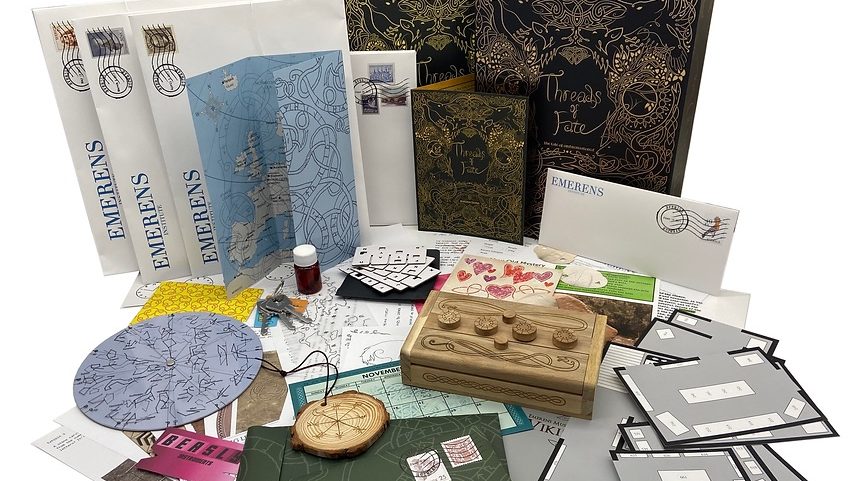
Threads of Fate (The Tale of Ord Remastered)
Review
Game Description
“Threads of Fate is a remastered version of PostCurious’ acclaimed debut game, The Tale of Ord. Taking on the role of a private investigator, you will be tasked with finding two missing professors from the Emerens Institute, but when information is uncovered about a mysterious relic found by an archaeological team, you will have the opportunity to change the course of destiny.
Provided with an assortment of letters, articles, drawings, websites, and physical artifacts, you will set out on a journey to explore the supernatural forces of Norse mythology and uncover the truth behind the disappearances. The meaning of mysterious glyphs will be revealed throughout the experience as you progress through the story and begin to unravel the secrets of fate and time.”
Personal Experience
PostCurious released The Tale of Ord back in 2018 to critical acclaim. Handmade, the release was limited to 500 copies. By the time I found about its existence in late 20201Thanks to the same Ars Technica article that helped introduce me to the hobby! those copies were long gone. I would have likely moved on and forgotten about it, however in the puzzle game community it was frequently spoken about both in highly reverent tones and with envy for those who were able to acquire and play one of the limited number of copies floating around. So, I knew I had to play it. I kept my eye out for copies for sale, always missing out due to bad timing or being outbid. I tried setting up a play-it-forward ring, where folks would guarantee to play it and send it along to fellow players if anybody was able to get their hands on a copy. But, the copies remained elusive; all of that was to no avail.
So, when designer Rita Orlov announced that PostCurious would be releasing a remastered version of the game, there was much rejoicing and anticipation. The fundraising campaign was a big success and—very impressively—was able to begin fulfilling the orders in less than a year. (Not an insignificant achievement given the current state of the global supply chain!) My copy arrived a few days before Christmas, making it the perfect gift from my past self.
I cracked open the box a few days after Christmas and found four large envelopes that divide the game into discrete parts. Knowing that I wanted to savor the experience, I took my time with it and limited myself to no more than one part per day. Each part took approximately 2-4 hours to complete and overall I spent a little over 11 hours immersed and enchanted by the story contained within.
After playing the other, uniformly excellent PostCurious games, I came into the game with high expectations and with years of built-up hype. The big question is, did the game meet those expectations and the hype? The answer is yes. Absolutely. It may have even exceeded them.
Narrative
PostCurious games are known for releasing strong, narrative-first productions. It’s such an important part of their style, that their experiences are labeled “puzzletales” instead of puzzle games or puzzle experiences. Threads of Fate continues that strong narrative streak, with a compelling story that hooks you early and leaves you thinking about it long after it’s over.
The game starts with you being commissioned to track down a research professor that’s gone missing. We’re handed a combination of journal entries, letters, and various musings that give us the clues we need to solve the disappearance, along with providing depth and character to the people we’re interacting with. It’s a strong start and I really loved that, much like in The Vandermist Dossier, it quickly becomes apparent that we’re not investigating a woman who has gone missing against her will, we’re investigating someone who has chosen to disappear. We know from the beginning that it’s not a whodunnit, the mystery is why this professor chose to disappear and how. Much more interesting questions, if you ask me.
Lending a hand to the narrative immersion is the way that the game blends reality and fiction. Like many other modern puzzle games, there are elements of the experience in the real world—like websites for fake institutions and email addresses that are programmed to respond to certain queries—that have been created to provide verisimilitude. However, in a fairly novel twist, there are real-world elements that have not been created by the developer that have been blended into the experience. I was stunned when I found the solution to one of the puzzles online and then realized that the site I was looking at was wikipedia.org. The items I were researching and discovering to solve this puzzle, existed out there in the world for me to actually find, if I so desired. The blending of real and fabricated elements in the puzzles blurred the lines between game and reality, giving the whole experience a thrill of possibility that I seldom get with puzzle experiences.
I always try really hard to spoil as little as possible in my reviews, so I don’t want to say too much about the back half of the game. What I will say is that as someone with pre-existing interests in Norse mythology, technology, and concepts like free will and destiny—all of which are blended into the narrative and puzzles—it felt like the game was bespoke just for me.
As you move through the game, eventually you will have a pretty major choice to make that affects the narrative. Usually, in situations like this, it feels like there’s one right choice and one wrong choice (or at least there is for my moral compass), but I was surprised (and impressed) to find that the arguments for both sides of the choice to be very compelling. It made me pause and question the choice I was making and why I was making it. A thrilling moment in what is easily one of the best narratives I’ve seen so far in the puzzle games I’ve played.
Puzzle Play
In addition to sporting a fantastic narrative, Threads of Fate also features some dynamite puzzle play across its four parts. Impressively, the puzzles in each part are interwoven2Like Threads one might say 😉 into the narrative and manage to make each part feel very distinctive from the others. As an example, the first part feels more like a traditional detective adventure, with you scouring documents for clues and hunting around the globe for objects that will lead you to a missing person. Whereas by part three, the puzzles take on a far more mythological and historical bent. The game feels cohesive as a whole, with puzzles in later parts building off of puzzles in earlier parts, and yet still manages to stay fresh throughout.
The experience does an excellent job of signposting the puzzles as you progress; I always knew which components were needed for which parts and never felt unsure about what my next step should be. Sometimes the signposting becomes part of the puzzle itself, as was the case in part three, which gives you a diagram of exactly what you’ll need to do in that act. The diagram is perfectly vague, spoiling nothing when you first look at it, but confirming you’re on the right path as you solve your way through.
I’m also going to take a break here to give a further shout out to part three of the experience. The puzzle designs in that segment were particularly inspired and if you separated that it out on its own, would be one of my favorite puzzle games ever. It was the longest part of the experience, taking me just over four hours split across two nights, but that time just absolutely flew by. I was so completely immersed that I started at 8pm and was startled to find that it was suddenly 11pm and I needed to pause for the night. In a word, fabulous.
The difficulty ramped up smoothly as the game went on, from an easy-medium difficulty in the first part to a medium-difficult difficulty in the last two parts. I seldom got stuck, but when I did there was an excellent hint site available that offered progressive hints and the ability to check if I had a correct solution without potentially spoiling me on the steps if I didn’t. The solution checker is extra welcome in this experience, where you often have to use solutions from one puzzle as inputs for other puzzles.
The numerous props and components that come with the game are well made and high quality, with even the introductory letters being printed on paper with a thick and sturdy weight. Overall, the components feel made to last and the included refill kit means that the game could easily be passed around a few times and still look great. There was also a prop that did something magical that I’ve not seen done before in a puzzle game. With this being my 85th puzzle game review, that feels pretty special these days.
Like the other PostCurious games, color does play a prominent role in a fair number of the puzzles. Thankfully, I was able to get through them all without any outside assistance, making this PostCurious’s most color accessible release to date. (Though, in wonderful news, some of the color issues I had in The Emerald Flame are being addressed in the second printing!)
Recommendation
With Threads of Fate, PostCurious has made something really special, that—amazingly—holds up to the massive amount of hype that The Tale of Ord had accumulated over the years. The puzzles and narrative here are so refined and well-written, that it makes me want to go back and play the original, just to see how much things have changed and how much stayed the same.
I’d recommend Threads of Fate to anyone reading this. If you’re here, you must like puzzle experiences and if you like puzzle experiences, I think you’ll love this game. I’ll be thinking about it for a long time to come.

Details
Type of Game: At Home Puzzle Game
Date Played: 2024-01-02
Price: $92
Company: PostCurious
Website: https://getpostcurious.com
Team Size: 1
Colorblind-friendly: Yes*
Outcome: Win



